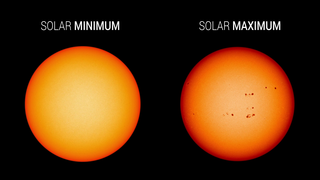Sun
ID: 4854
Coronal holes are large dark regions in the solar atmosphere that appear in extreme ultraviolet (EUV) and X-ray wavelength imagery.
These holes are created by large regions of the solar magnetic field that have a single polarity (unipolar) and extend far out into the solar system. These are sometimes called 'open' magnetic field lines since they don't connect back to the Sun. The regions appear dark because they have a lower density of the hot coronal plasma. The open magnetic field lines make it easy for the charged plasma to stream away from the Sun, forming the fast component (about 700 kilometers per second) of the solar wind.
Coronal holes can form at any time during the 11-year solar cycle but are more prominent near solar minimum when persistent coronal holes can form near the Sun's polar regions. Coronal holes can grow and migrate to lower solar latitudes.
Coronal Holes at Solar Minimum and Solar Maximum
These holes are created by large regions of the solar magnetic field that have a single polarity (unipolar) and extend far out into the solar system. These are sometimes called 'open' magnetic field lines since they don't connect back to the Sun. The regions appear dark because they have a lower density of the hot coronal plasma. The open magnetic field lines make it easy for the charged plasma to stream away from the Sun, forming the fast component (about 700 kilometers per second) of the solar wind.
Coronal holes can form at any time during the 11-year solar cycle but are more prominent near solar minimum when persistent coronal holes can form near the Sun's polar regions. Coronal holes can grow and migrate to lower solar latitudes.
Used Elsewhere In
Visualization Credits
Tom Bridgman (Global Science and Technology, Inc.): Lead Visualizer
Joy Ng (USRA): Producer
Laurence Schuler (ADNET Systems, Inc.): Technical Support
Ian Jones (ADNET Systems, Inc.): Technical Support
Joy Ng (USRA): Producer
Laurence Schuler (ADNET Systems, Inc.): Technical Support
Ian Jones (ADNET Systems, Inc.): Technical Support
Please give credit for this item to:
NASA's Scientific Visualization Studio
NASA's Scientific Visualization Studio
Short URL to share this page:
https://svs.gsfc.nasa.gov/4854
Mission:
SDO
Data Used:
Note: While we identify the data sets used in these visualizations, we do not store any further details nor the data sets themselves on our site.
Keywords:
SVS >> Ultraviolet Imagery
SVS >> Solar Activity
SVS >> Solar Magnetic Field
NASA Science >> Sun
SVS >> EUV Imaging
SVS >> Coronal Holes
https://svs.gsfc.nasa.gov/4854
Mission:
SDO
Data Used:
SDO/AIA/193 Filter also referred to as: AIA 193
JOINT SCIENCE OPERATIONS CENTER - 2014-04-12 to 2014-04-17 and 2019-10-18 to 2019-10-23Keywords:
SVS >> Ultraviolet Imagery
SVS >> Solar Activity
SVS >> Solar Magnetic Field
NASA Science >> Sun
SVS >> EUV Imaging
SVS >> Coronal Holes












